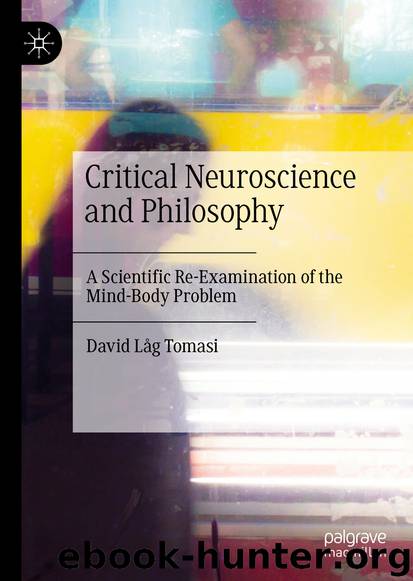Critical Neuroscience and Philosophy by David Låg Tomasi

Author:David Låg Tomasi
Language: eng
Format: epub
ISBN: 9783030353544
Publisher: Springer International Publishing
This discussion moves far beyond rational-mechanistic approaches based on empirical experimentation, especially given that, in Lossky’s view (and in classical Christian orthodoxy) theosis is above (human) knowledge. This perspective goes against the commonly accepted view in modern science, according to which research follows an artificially pre-constructed idea about a process, and then it tries to find out whether its existence is warranted, via experimental processes. The opposite process happens in both mysticism and postmodern approach, where “one understands something and then tries to get an idea about it” (Schaef 1992). But how can we relate to such deep spiritual and religious worldviews and still maintain the scientific mind when analyzing our nervous system? As we have previously seen, pyramidal neurons are involved in electrochemical activity, at a neocortical level, of synchronized action potentials which in turn are responsible for the memory-based foundations of consciousness. Thus, from this perspective, there are specific mechanisms involved in the creation, maintenance and development of consciousness, in the sense that we are conscious of explicit memories of external and internal phenomena. However, this relation between what is inside and what is outside is quite difficult to understand, especially because we are “both the inside observer and the outside observed”, as well as all the combinations therein. If we took the Cartesian dualistic view, we would maintain that both mind and body (brain) are separate, yet united; diverse, but correlated; distinct types of (the same?) substance. To shed light on the essence of the substance and the matter-at-hand, we could also say that, according to Descartes, our brain is part of a spatially extended body, thus substance, while our minds are unextended. In any case, the relationship can only work if and only if there is (a) a clear separation between (these two) things and (b) a certain level of communication between them. Also, a series of problems might arise when we are attempting to identify the “hard problem of consciousness” on the level of subjective perceptions, feelings, emotions, thoughts, actions, reactions, and behaviors, and their neural correlates, objectively understood as mechanistically equivalent in every subject given the same external/internal conditions, starting from gross neuroanatomy, down to neurotransmitters and neuroreceptors, brain function and activity, including action potentials, and internal–external environment, upbringing, social circumstances and so on.
Furthermore, even when all these parts can be appropriately combined to give rise to a whole of objective/observable-turned-to-subjective apparatus, we still couldn’t be 100% sure that neuronal correlates are actually causing-creating (our and subjective) consciousness. This is also because theoretically intended, we will have to identify product/agency-specific properties underlying the whole process and creating sequential follow-ups, at least on an algorithmic basis. At this stage the enormous complexity of the ‘first-person experience’ is truly difficult to replicate and understand from the outside, although some very convincing theoretical frameworks such as IIT appear to have provided very good starting points. In any case, if we took as a hypothetical assumption that the existence of the souls has warrant for belief and would
Download
This site does not store any files on its server. We only index and link to content provided by other sites. Please contact the content providers to delete copyright contents if any and email us, we'll remove relevant links or contents immediately.
Periodization Training for Sports by Tudor Bompa(7891)
Why We Sleep: Unlocking the Power of Sleep and Dreams by Matthew Walker(6307)
Paper Towns by Green John(4756)
The Immortal Life of Henrietta Lacks by Rebecca Skloot(4226)
The Sports Rules Book by Human Kinetics(4048)
Dynamic Alignment Through Imagery by Eric Franklin(3891)
ACSM's Complete Guide to Fitness & Health by ACSM(3792)
Kaplan MCAT Organic Chemistry Review: Created for MCAT 2015 (Kaplan Test Prep) by Kaplan(3776)
Introduction to Kinesiology by Shirl J. Hoffman(3603)
Livewired by David Eagleman(3514)
The River of Consciousness by Oliver Sacks(3384)
The Death of the Heart by Elizabeth Bowen(3314)
Alchemy and Alchemists by C. J. S. Thompson(3270)
Descartes' Error by Antonio Damasio(3141)
Bad Pharma by Ben Goldacre(3067)
The Gene: An Intimate History by Siddhartha Mukherjee(2897)
The Emperor of All Maladies: A Biography of Cancer by Siddhartha Mukherjee(2882)
The Fate of Rome: Climate, Disease, and the End of an Empire (The Princeton History of the Ancient World) by Kyle Harper(2841)
Kaplan MCAT Behavioral Sciences Review: Created for MCAT 2015 (Kaplan Test Prep) by Kaplan(2783)
